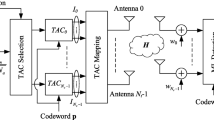Abstract
In this paper, we investigate how to send space-time codes with full diversity and low decoding complexity for interference channels using precoders. We assume that we have two transmitters and two receivers. Each transmitter sends codewords to respective receiver at the same time. We propose an orthogonal transmission scheme that combines space-time codes and array processing to achieve low-complexity decoding and full diversity for transmitted signals. To our best knowledge, this is the first scheme which can achieve low-complexity decoding and full diversity for any transmitted codeword in interference channel when all the users transmit at the same time. Simulation results validate our theoretical analysis.
Similar content being viewed by others
References
Jafarkhani H. (2005) Space-Time Coding: Theory and Practice. Cambridge University Press, Cambridge
Gärtner, M. & Bölcskei, H. (2006). Multiuser space-time/frequency code design. In Proceedings of IEEE international symposium on information theory.
Badr, M. & Belfiore, J.-C. (2008). Distributed space-time codes for the non cooperative multiple-access channel. In Proceedings IEEE International Zurich seminar on communications, pp. 132–135.
Badr, M. & Belfiore, J.-C. (2008). Distributed space-time codes for the MIMO multiple access channel. In Proceedings of IEEE international symposium on information theory, pp. 2553–2557.
Hong Y., Viterbo E. (2009) Algebraic multiuser space-time block codes for a 2 × 2 MIMO. IEEE Transactions on Vehicular Technology 58(6): 3062–3066
Lu H., Vehkalahti R., Hollanti C., Lahtonen J., Hong Y., Viterbo E. (2009) New space-time code constructions for two-user multiple access channels. IEEE Journal of Selected Topics in Signal Processing 3(6): 939–957
Zhang W., Letaief K. B. (2010) A systematic design of full diversity multiuser space-frequency codes. IEEE Transactions on Signal Processing 58(3): 1732–1740
Tarokh V., Naguib A., Seshadri N., Calderbank A. R. (1999) Combined array processing and space-time coding. IEEE Transactions on Information Theory 45: 1121–1128
Naguib, A. F., Seshadri, N. & Calderbank, A. R. (1998). Applications of space-time block codes and interference suppression for high capacity and high data rate wireless systems. In Proceedings of Asilomar conference on signals, systems and computers.
Li F., Jafarkhani H. (2011) Interference cancellation and detection for more than two users. IEEE Transactions on Communications 59(3): 901–910
Kazemitabar J., Jafarkhani H. (2008) Multiuser interference cancellation and detection for users with more than two transmit antennas. IEEE Transactions on Communications 56(4): 574–583
Li F., Jafarkhani H. (2011) Multiple-antenna interference cancellation and detection for two users using quantized feedback. IEEE Transactions on Wireless Communication 10(1): 154–163
Li F., Jafarkhani H. (2009) Multiple-antenna interference cancellation and detection for two users using precoders. IEEE Journal of Selected Topics in Signal Processing 3(6): 1066–1078
Annapureddy V. S., Veeravalli V. V. (2011) Sum capacity of MIMO interference channels in the low interference regime. IEEE Transactions on Information Theory 57(5): 2565–2581
Sun, C., Karmakar, N. C., Lim, K. S. & Feng, A. (2004). Combining beamforming with Alamouti scheme for multiuser MIMO communications. In Proceedings of Vehicular Technology Conference.
Huang, J., Au, E. & Lau, V. (2007). Precoding of space-time block codes in multiuser MIMO channels with outdated channel state information. In Proceedings of the IEEE international symposium on information theory (ISIT ’07).
Malkam E., Leib H. (1999) Coded diversity on block-fading channels. IEEE Transactions on Information Theory 45(2): 771–781
Ozarow L., Shamai S., Wyner A. D. (1994) Information theoretic considerations for cellular mobile radio. IEEE Transactions on Vehicular Technology 43: 359–378
Cadambe V. R., Jafar S. A. (2008) Interference alignment and the degrees of freedom for the K user interference channel. IEEE Transactions on Information Theory 54(8): 3425–3441
Alamouti S. M. (1998) A simple transmit diversity technique for wireless communications. IEEE Journal on Selected Areas in Communications 16(8): 1451–1458
Simon M. K., Alouini M. -S. (2000) Digital communication over fading channels. (1st ed.). Wiley, New York
Bayer-Fluckiger E., Oggier F., Viterbo E. (2004) New algebraic constructions of rotated Z n-lattice constellations for the Rayleigh fading channel. IEEE Transactions on Information Theory 50: 702–714
Author information
Authors and Affiliations
Corresponding author
Rights and permissions
About this article
Cite this article
Li, F. Array Processing for Multi-User Multi-Antenna Interference Channels Using Precoders. Wireless Pers Commun 69, 285–297 (2013). https://doi.org/10.1007/s11277-012-0573-y
Published:
Issue Date:
DOI: https://doi.org/10.1007/s11277-012-0573-y




